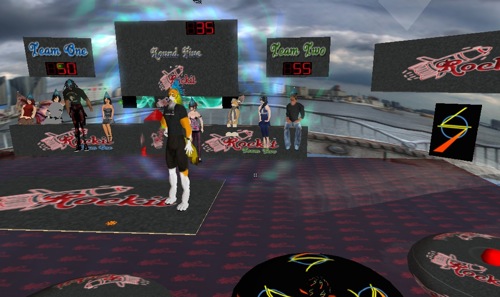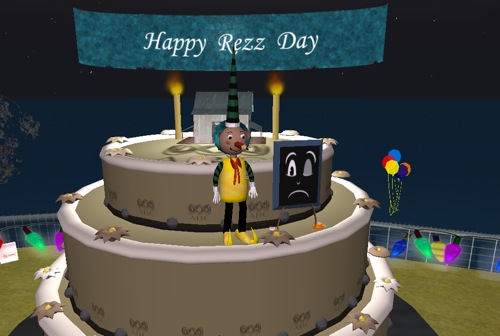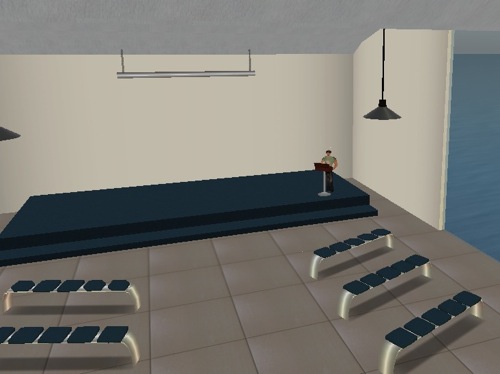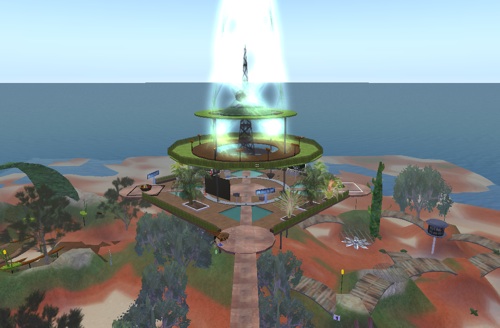1. STAR WARS – SECOND LIFE – Promo Teaser Trailer
2. Daliwolf and Beth’s Second Life Wedding
3. “The Far Away” in Second Life
Tech -- Culture -- Humour
1. STAR WARS – SECOND LIFE – Promo Teaser Trailer
2. Daliwolf and Beth’s Second Life Wedding
3. “The Far Away” in Second Life
1. Habbo Australia have surveyed 4012 teenagers (12-18 year olds) on their concerns, with 81% citing the environment as a major issue, with an unsurprising emphasis on bushfires.
Habbo will be closing down for Earth Hour on March 28th at 8.30pm AEDT. What say you Linden Lab, Blizzard and others?

2. The Alphaville Herald has some stunning pictures of Metaplace builds – it shows the potential power of a well-implemented 2D platform.
3. There’s been quite a lot of focus on this week’s announcement of Sparkle, which allows in-world text chat in Second Life and in OpenSim grids on the iPhone or iPod Touch. Here’s a brief demo:
More on Sparkle once we have a closer look in the next few days.
Over at Second Effects, Second Life resident and business owner ArminasX Saiman has compiled (via Technorati rankings) an enormous list of Second Life sites.
The list is worth a browse purely for the huge variety of sites out there devoted to Second Life. Any rankings system is pretty arbitrary, but major kudos to ArminasX for putting such a comprehensive resource together.
A handful of pics from the successful event last evening. Some good trivia by Wolfie Rankin, goodmusic by Komuso Tokugawa and an overall great night thanks to the ABC Admin team.





1. Ars Technica (USA) – Real banking coming to virtual worlds. “Virtual economies of MMO games have been becoming increasingly intertwined with real-world money over the past few years. Titles like Second Life allow players to exchange cash for in-game currency, while others like EVE Online are player-driven and don’t limit currency or materials in the game’s economy. Now, however, the lines are being blurred even further, as a Swedish video game developer has been granted preliminary approval for a real banking license by the Swedish Finance Supervisory.”
2. Gerson Lehrman Group – High risk, High Reward: MMOGs as the Next Wave of Entertainment Media. “Gazillion Entertainment has captured headlines by inking a long-term deal with Marvel for creating online games based on Marvel’s characters. Gazillion also has other IP-related agreements, such as LEGO World. The company acquired online developer NetDevil last year and has quietly acquired other small studios to build up to their current 300-strong team. This is not the first agreement to produce online games (massively multiplayer online games — MMOGs — or virtual worlds, which are becoming increasingly synonymous) based on mass-market properties, but it is notable in its breadth and term: apparently all of Marvel’s 5000+ characters are included, and for a span of ten years. Successful MMOGs typically take 2-3 years to produce, so there is some room for a running start there, and historically these products have retained strong revenue for between five and ten years, making a long-term agreement like this sensible.”
3. MSNBC (USA) – UC San Diego and IBM Launch Center for Next-Generation Digital Media to Power Tomorrow’s Virtual Worlds. “Researchers at the University of California, San Diego today announced plans for a new campus center dedicated to invent the next generation of virtual worlds, multiple player online games, and high fidelity digital cinema, using one of the world’s most sophisticated computer servers — the IBM System z mainframe. IBM (NYSE: IBM) provided a Shared University Research (SUR) award to help the university jump-start its new Center for Next-Generation Digital Media on the UC San Diego campus. In addition to multiple peripherals and additional support, the IBM award consists of the company’s newest System z10 Enterprise Class server with the Cell Broadband Engine (Cell/B.E.).”
4. ReadWriteWeb (USA) – Finally, A Practical Use for Second Life. “When you think of virtual worlds, the first one that probably pops into your head is Second Life, but in reality, there are a number of different virtual worlds out there. There are worlds for socializing, worlds for gaming, even worlds for e-learning. But one thing that most virtual worlds have in common is that they are places for play, not practicality. (Yes, even the e-learning worlds are designed with elements of “fun” in mind). Outside of some reports that virtual worlds will replace web conferencing in the enterprise, we haven’t seen a lot of innovation in this space which would make businesses sit up and take notice. However, that may be about to change thanks to new software that lets you perform data visualization and manipulation techniques within the virtual world environment.”
5.The Ontarian (Canada) – Out of the dungeon and into the chat room. “Just over a decade ago the release of the popular romantic comedy, You’ve Got Mail, helped make the concept of meaningful social interaction online seem realistic and accessible to the average internet user. The Matrix, released a year later in 1999, likewise offered a vision of a shared virtual existence (though admittedly with more sinister implications). At around this time, the internet was a rather new and startling phenomenon to the average person. According to the International Telecommunication Union, developed nations saw only 17 per cent internet usage in 1998. Measured against a much more prominent 62 per cent in 2007. Canada in particular has a high number of net users at 84.3 per cent of the total population according to a recent estimate by Internet World Stats. In Canada, the internet has become a tightly woven part of our social fabric, changing the way we interact. Where you used to ask for someone’s number you might ask for their email or you might Facebook them (sometimes without their consent).”
6. The Industry Standard (USA) – 3D data visualizations in virtual worlds: A “wonderful advance” or fancy window-dressing? “Will “walking” through your data help you understand it better? The folks at Green Phosphor think it will, and hope to convince you. Their product Glasshouse, currently in beta, will place interactive data presentations into virtual worlds like Wonderland and Second Life. Company founder and CEO Ben Lindquist posted an article at CyberTech News Saturday describing the service. “Users can see data, and drill into it; re-sort it; explore it interactively — all from within a virtual world. Glasshouse produces graphs which are avatars of the data itself.”
7. The Chronicle of Higher Education (USA) – New Research Center to Design ‘Next Generation’ of Virtual Worlds. “Watch out, Second Life. The University of California at San Diego announced today the creation of a new research center aimed at creating the “next generation†of virtual worlds, which designers hope will be more visually rich and have more features than Second Life and other popular online environments. The center will use a new hybrid-computing platform developed by IBM. Sheldon Brown, a professor of visual arts at the university who is also the director of the new center, said artists working with simulations have been limited by the computing technologies available. The new IBM platform, Mr. Brown said, offers an increased level of flexibility and power that will give artists more freedom.”
8. The Associated Press – Hillary Clinton, e-diplomat, embraces new media. “Her videos aren’t quite viral yet and she’s not tweeting, but Secretary of State Hillary Rodham Clinton is embracing new media, using the Web to promote the agency and her role as the nation’s top envoy.
In less than three months, Clinton’s State Department has embarked on a digital diplomacy drive aimed at spreading the word about American foreign policy and restoring Washington’s image. Part of a broader Internet outreach by President Barack Obama’s administration, Clinton’s Web efforts already have outpaced those of her predecessors.”
9. Church Solutions (USA) – Church 2.0: What It Means and Why It’s Important. “I’m working on a strange sort of book titled “Church 2.0.†Often, when I’m at conferences, I run into several church leaders who aware of the project and ask what the book is about, which makes me realize I need to explain my definition of Church 2.0. You see, when most people hear my book title they automatically think of one of two things: technology or theology. Assuming the book is about technology is understandable for a few reasons. First, the term closely resembles “Web 2.0,†which refers to the recent wave of increased interactivity and social networking on the Internet. I do cover this topic but so much more, also. Another reason many assume this book is about technology is I am the Director of Technical Arts at a church. I write and speak on technology, and I have a blog called ChurchVideoIdeas.com. But this book is currently divided into three sections and technology is only one of them. My hope is that once the book is released and word spreads, the term “Church 2.0†will be much larger and more definitive than just using Web 2.0 in a church setting.”
10. CNET (USA) – Sony says 4 million go home to PlayStation Home. “In an interview with GameDaily, Sony’s senior marketing vice president Peter Dille has revealed some stats on PlayStation Home, Sony’s online virtual community, which was greeted with a rather lukewarm reception when it launched late last year. Word is 4 million people have come into Home and those who do stick around stick around for 55 minutes on average.
Sony doesn’t differentiate between active and idle users (by idle, I mean you’ve gone in once, checked it out, and never gone back), so it’s hard to say how many folks are really hard-core Home dwellers. However, what’s clear is that now that it’s had an opportunity to mature a bit, the company is making a push to publicize the virtual world that Sony officials have admitted has been a challenge to build and maintain.”
On Friday March 16th 2007, members of the ABC Friends group in Second Life got to see the completed ABC Island, with the public launch on the 19th March to coincide with the Four Corners episode ‘You Only Live Twice’.
Since that time there’s been a regular and dedicated community on ABC Island that have ensured its ongoing evolution, in conjunction with the ABC Staff responsible for its administration.
To celebrate the two-year anniversary, there’s an event on this evening, starting at 7.30pm AEDT. First up is Rockit, the music trivia event with a difference – anyone who turns up can potentially compete and it’s a lot of fun. After Rockit wraps up at 9.30pm, the plan is for a live music performance by Komuso.

We’ve mentioned it numerous times: the most successful virtual world locations are ones with a critical mass of people who consider it their community, and work to make it a fun place to be. ABC Island’s community has had its fair share of ups and downs, personality conflicts and technical challenges, but after two years it’s still standing strong. It’s fair to say that the ABC aren’t placing its Second Life presence that high up its priorities but credit due to the advocates at the ABC who have managed to keep this small community innovation a lively part of the Australian virtual worlds community.
Linden Lab have posted two useful stories on their blog that are worth passing on.
The first is a heads-up on a Knowledge Base article on how to instant message a group of up to 20 of your friends without them being in a group you’ve created.

The second is a look at how an in-world meeting was held for 160 people in Second Life. The standout sentence for me was:
Gronstedt led all participants through a 30-minute training session and all speakers and exhibitors through a 60-minute training session to ensure that when the conference day arrived, everyone was ready to walk, talk, text chat, and participate in this new virtual event experience.
Half an hour to an hour of training to be able to participate isn’t that high a premium, although without doubt it’d be a disincentive to a lot of people. To me, that’s a big hurdle for one-off meetings but a more than worthwhile expense for a business using virtual meetings regularly. Of course, the enterprise solution that reduces the learning curve even further will have an advantage as enterprise comes on board with offerings that reduce real-world travel expenses.
1. Happy Saint Patricks Day – Second Life
2.The Kaaos Effect trailer – a new game in Second Life by MadPea Productions
(More info on this at Massively)
3. Playstation Home Video
1. Intranet consultants Step Two designs have announced entries are open for the 2009 Intranet Innovation Awards, and they’re looking for entries that demonstrate the use of virtual worlds within the enterprise. Alex Manchester is a Senior Consultant at Step Two:
“We’ve yet to see virtual worlds really break into the internal corporate environment, but there’s undoubtedly a lot happening in this space. It would be great to see some entries this year from organisations leading the way with business uses of virtual worlds, be that for communication, training, collaboration or something entirely different.”
2. The Virtual Worlds – Best Practices in Education conference is held in Second Life and this year’s is coming up 27th-29th March. You can register here.

3. ABC Island in Second Life hits the two-year mark since it opened to the public. We’ll write more on the milestone later in the week and there’s likely to be some celebrations in-world over the weekend.
British firm Daden have been releasing virtual worlds products for a while now – we covered their in-world web browser last July. Their latest launch is an “open-source learning system or virtual worlds, the web and iPhone”. Its moniker is PIVOTE and it’s the result of a project called PREVIEW funded by the UK Government’s Joint Information Systems Committee (JISC). The project’s focus was problem-based learning in virtual worlds, and PIVOTE is the end-result. Paramedic training for St George’s, University of London was the initial focus that’s led to final product.

Essentially, Pivote is a web-based learning management system where detailed exercises can be formulated as fairly standard, text-driven scenarios with decision pathways, or as avatar driven exercises in Second Life or OpenSim (Daden states its platform can easily be adapted to other virtual worlds). The text-based options can also be utilised in-world via what is presumably Daden’s in-world browser. St George’s have a sim in Second Life (click here to see for yourself) that is publicly accessible.
St George’s Senior Lecturer in Paramedic Science, Alan Rice said “This programme provides the students with a fun learning environment, where they can afford to make mistakes online, which they could not afford to make in the real world. When they make a mistake online, they are always keen not to make the same mistake again.†A paramedic student at St George’s, Fiona Cropp, was happy with the virtual training process – “It’s a really useful tool. It’s much better to be able to actually perform treatments rather than just talk about it. Everyone is online at the same time so you can bounce ideas off each other and make an informed decision. I had never used Second Life before, but I found it really easy to get on with.â€
A useful overview of the paramedic training scenario can be viewed here:
Pivote isn’t the first integrated training solution using virtual worlds, but it’s certainly progressed things considerably. The challenge for any platform is convincing key management that scarce health dollars should be sunk into virtual worlds-based training. Health professionals and academics are perfectly positioned to demonstrate just that, and there’s no shortage of evidence of the cost benefits of effectively trained clinicians. Anything that increases the confidence of new practitioners in the breadth of the clinical decision-making in a cost-effective way, will surely gain some traction in what is usually a very conservative space.
Anyone wanting to install PIVOTE for themselves can do so for free by installing it on their own servers or paying Daden to host it for them. The full instructions can be found by browsing the ‘Getting Started’ section of the PIVOTE website.
Copyright © 2024 · Magazine Child Theme on Genesis Framework · WordPress · Log in
Recent Comments